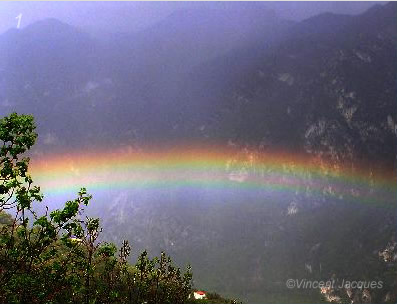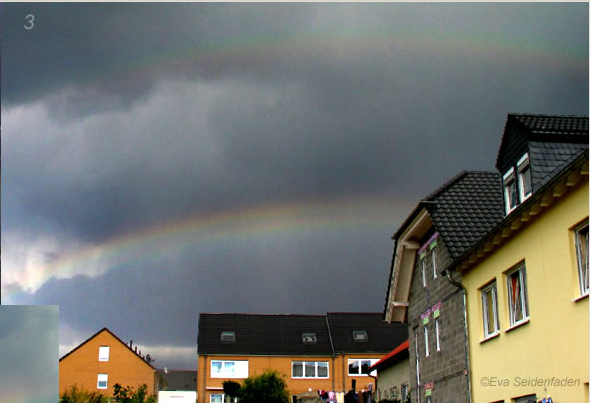Twinned bows
Twinned Bows: An Enigmatic Atmospheric Phenomenon
Twinned bows, a captivating atmospheric optical phenomenon, have puzzled scientists and observers for centuries. Unlike supernumeraries, which are faint, closely spaced colored bands that appear on the inner edge of rainbows, twinned bows are characterized by the splitting of the primary and secondary bows. Although an agreed explanation for their occurrence remains elusive, one theory suggests that non-spherical raindrops or ice spheres may be responsible for their formation.
Several remarkable instances of twinned bows have been documented, providing valuable insights into this intriguing phenomenon. For instance:
-
In May 2004, Vincent Jacques captured a stunning image of twinned bows at Breil in the French Alpes-Maritimes. The photograph showcases the distinct split in both the primary and secondary bows, raising questions about the mechanisms behind their formation.
-
Serge Vasseur observed twinned bows on a summer day in July 2004, following a thunderstorm that concluded with heavy rain, small transparent hailstones, and scattered snowflakes. This observation highlights the potential relationship between atmospheric conditions and the appearance of twinned bows.
-
Eva Seidenfaden's photograph from September 2005, taken in Trier, Germany, reveals a secondary bow that is not split. This observation aligns with simulations conducted using non-spherical water drops, suggesting that the shape of the droplets may play a role in the formation of twinned bows.
While these documented instances provide valuable visual evidence, the underlying mechanisms behind twinned bows remain shrouded in mystery. Scientists continue to explore various hypotheses to explain this enigmatic phenomenon. Here are some theories that have been proposed:
-
Non-spherical Raindrops: One possibility is that non-spherical raindrops contribute to the formation of twinned bows. The irregular shape of these raindrops could result in the splitting of the primary and secondary bows, creating the distinctive appearance of twinned bows.
-
Ice Spheres: Another theory suggests that ice spheres, rather than raindrops, may be responsible for twinned bows. These spherical ice particles could interact with sunlight in a way that produces the observed splitting effect.
-
Complex Light Scattering: The scattering of light within raindrops or ice spheres may also play a role in the formation of twinned bows. The intricate interplay of light rays within these particles could result in the splitting of the primary and secondary bows, leading to the formation of twinned bows.
Despite these theories, further research is needed to definitively understand the mechanisms behind twinned bows. The complexity of light scattering and the diversity of atmospheric conditions make it challenging to replicate these phenomena in controlled experiments. However, advancements in computational modeling and high-resolution imaging techniques offer hope for unraveling the mysteries of twinned bows in the future.
In conclusion, twinned bows represent a captivating and perplexing atmospheric optical phenomenon. While their distinctive appearance has been observed and documented, an agreed explanation for their occurrence remains elusive. Theories involving non-spherical raindrops, ice spheres, and complex light scattering have been proposed but require further investigation. As scientists continue to explore and analyze these enigmatic phenomena, we are left in awe of the natural wonders that grace our skies.



Twinned bows, not to be confused with supernumeraries, do not have an agreed explanation but they could be produced by non-spherical raindrops or ice spheres.
(1) Imaged by Vincent Jacques (site) at Breil in the French Alpes-Maritimes, 5th May 2004.
(2) Serge Vasseur (site) saw these bows on July 17, 2004 (sun 15.5° high) at Presles, France. The bows occurred after a thunderstorm ending with heavy rain, small transparent hailstones and some scattered snowflakes.
(3) Imaged by Eva Seidenfaden (site) at Trier, Germany on Sept 11, 2005. The secondary bow is not split - in agreement with simulations from non-spherical water drops.
Images are the copyright of the individual photographers and shown here with permission.
Note: this article has been automatically converted from the old site and may not appear as intended. You can find the original article here.
Reference Atmospheric Optics
If you use any of the definitions, information, or data presented on Atmospheric Optics, please copy the link or reference below to properly credit us as the reference source. Thank you!
-
<a href="https://atoptics.co.uk/blog/twinned-bows/">Twinned bows</a>
-
"Twinned bows". Atmospheric Optics. Accessed on November 9, 2024. https://atoptics.co.uk/blog/twinned-bows/.
-
"Twinned bows". Atmospheric Optics, https://atoptics.co.uk/blog/twinned-bows/. Accessed 9 November, 2024
-
Twinned bows. Atmospheric Optics. Retrieved from https://atoptics.co.uk/blog/twinned-bows/.